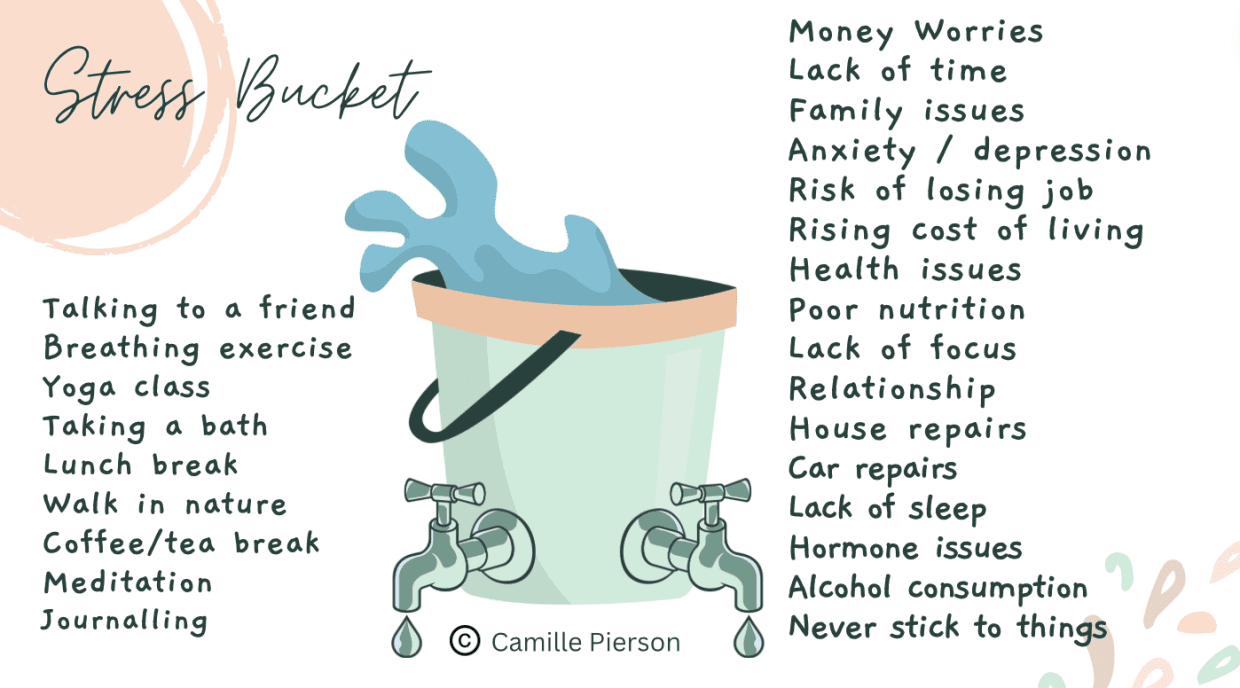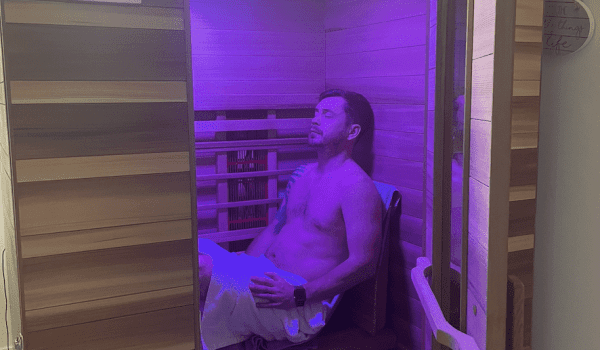The Stress Bucket Analogy and Its Implications
Understanding how stress impacts us and learning practical strategies to manage it is crucial for maintaining our well-being and productivity at work. To make this more tangible, we’ll use the stress bucket analogy.
The Stress Bucket Analogy
 Imagine each of us has a bucket that collects stress. This bucket represents our capacity to handle stress.
Imagine each of us has a bucket that collects stress. This bucket represents our capacity to handle stress.
- Size of the Bucket: The size of each person’s stress bucket is different. Some people have a larger capacity for stress, while others have a smaller one. Factors such as genetics, personality, and life experiences determine the size of our bucket.
- Filling the Bucket: Every time we encounter a stressful situation—whether it’s a tight deadline, a difficult conversation with a colleague, or balancing work and home responsibilities—our bucket fills a bit more.
- Overflow: When the bucket gets too full, it overflows. This overflow represents when we start to feel overwhelmed, anxious, or burnt out.
- Draining the Bucket: The key to managing stress is to find ways to “drain” our bucket regularly. Just as water can overflow if not drained, our stress can become overwhelming if we don’t have effective ways to relieve it.
The Sympathetic and Parasympathetic Nervous Systems
To understand why managing stress is so important, let’s briefly delve into the nervous system, which regulates our body’s responses to stress.
- Sympathetic Nervous System (SNS):
- Function: Known as the “fight or flight” system, the SNS prepares the body to deal with threats.
- Activation: When we perceive a stressful situation, the SNS triggers a cascade of physiological changes: increased heart rate, rapid breathing, and the release of stress hormones like adrenaline and cortisol.
- Short-term Benefit: This response is beneficial in acute situations, like avoiding an accident, as it prepares us to react quickly.
- Parasympathetic Nervous System (PNS):
- Function: Often called the “rest and digest” system, the PNS helps the body to calm down and recover after the perceived threat has passed.
- Activation: It slows the heart rate, decreases blood pressure, and promotes digestion and energy storage.
- Long-term Benefit: Prolonged activation of the PNS is essential for health and recovery, counterbalancing the stress responses of the SNS.
The Impact of Chronic Stress
When our stress bucket overflows frequently, or we don’t drain it effectively, our bodies stay in a state of chronic stress. This means our sympathetic nervous system is activated more often than it should be, and the parasympathetic systemdoesn’t have enough opportunity to restore balance.
Effects of Chronic Stress:
- Physical Health:
- Cardiovascular Issues: Persistent high blood pressure and increased heart rate can lead to heart disease.
- Digestive Problems: Conditions like irritable bowel syndrome (IBS) can be exacerbated.
- Immune System Suppression: Chronic stress weakens the immune system, making us more susceptible to illnesses.
- Mental Health:
- Anxiety and Depression: Continuous stress can lead to mental health issues, as the brain remains in a constant state of alertness.
- Cognitive Impairments: Memory, concentration, and decision-making abilities can suffer due to ongoing stress.
- Behavioural Changes:
- Sleep Disturbances: Stress often leads to insomnia or poor-quality sleep.
- Substance Abuse: Individuals may turn to alcohol, drugs, or unhealthy eating as coping mechanisms.
Managing Stress Through Micro Practices
Given the substantial impact of chronic stress, it’s essential to find effective ways to manage it. One practical approach is incorporating micro practices into our daily routine.
What are Micro Practices?
Micro practices are short, frequent breaks taken throughout the workday. They can range from 30 seconds to 5 minutes and involve stepping away from work tasks to do something relaxing or rejuvenating.
Benefits of Micro Practices:
- Physical Relaxation: Brief periods of physical activity or stretching can alleviate muscle tension and reduce the risk of repetitive strain injuries.
- Mental Rejuvenation: Shifting focus away from work, even momentarily, helps clear the mind and reduces mental fatigue.
- Enhanced Productivity: Regular breaks prevent burnout and maintain high levels of productivity by keeping energy and concentration levels stable.
Types of Micro Practices:
- Breathing Exercises: Simple deep-breathing techniques can activate the parasympathetic nervous system, helping to calm the body and mind.
- Mindfulness or Meditation: Taking a few minutes to meditate or practice mindfulness can reduce stress and improve mental clarity.
- Physical Movement: Standing up, stretching, or taking a short walk can relieve physical stress and refresh your focus.
- Social Interaction: Briefly chatting with a colleague can provide a mental break and foster a sense of connection.
- Hydration and Nutrition: Taking time to drink water or have a healthy snack can boost energy and support overall well-being.
Implementing MicroPractices in the Workplace
Creating a Supportive Culture:
- Encourage Regular Breaks: Promote a culture where taking short, regular breaks is normalized and encouraged.
- Lead by Example: Managers and team leaders should model taking micro breaks to set a positive example.
- Provide Resources: Offer tools and resources such as relaxation apps, guided meditation sessions, or comfortable break areas.
Practical Tips:
- Schedule Breaks: Set reminders or use apps to prompt regular breaks throughout the day.
- Use Breaks Effectively: Engage in activities that truly relax and rejuvenate you, rather than just scrolling through your phone.
- Listen to Your Body: Pay attention to signs of stress or fatigue and take breaks accordingly.
Conclusion
In conclusion, managing stress is not just about surviving the workday but thriving in it. By understanding the stress bucket analogy and how our nervous system responds to stress, we can appreciate the importance of regular, mindful breaks. Incorporating micro breaks into our routine is a powerful, practical way to keep our stress levels in check and our productivity high.
Remember, maintaining a balance between the demands of work and the needs of our body and mind is not just a luxury—it’s essential for long-term health and success. Let’s make it a priority to manage our stress effectively, for our well-being and for a more productive and positive workplace.










